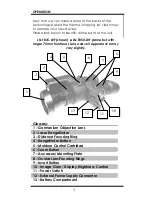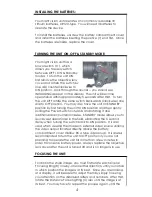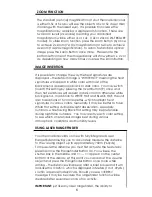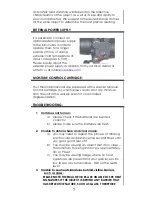
7
accurately read distance will depend on the reflective
characteristics of the object, as well as its size and ability to
view it unobstructed. We suggest to measure distance 3 times
for the same object to determine the most precise reading.
EXTERNAL POWER SUPPLY
It is possible to connect an
optional external power supply
to the binoculars in order to
operate them for a longer
periods of time, or during
extreme cold temperature of
minus 10 degrees C (14F).
Please inquire about the
external power supply availability from your local dealer or
write to us at
MOISTURE CONTROL CARTRIDGE:
Your thermal binoculars are equipped with a special Moisture
Control Cartridge (5), which allows removal of any moisture
from the unit in the unlikely event of uncontrolled
depressurization.
TROUBLESHOOTING:
1.
Unit does not turn on:
a)
please check if the batteries are inserted
correctly
b)
please make sure the batteries are fresh
2.
Unable to obtain sharp and clear image:
a)
you may need to repeat the process of rotating
each ocular and distance ring several times until
you get a good feel of it
b)
You may be viewing an object that it too close –
the minimum focusing distance is approximately
3m or 9 feet
c)
You may be viewing image where no heat
signatures are present and your gain level is too
low to see any surroundings. Dial up the GAIN
level.
3.
Unable to see heat signatures behind visible barriers,
such as glass:
PLEASE NOTE: THERMAL DEVICES ARE UNABLE TO SEE HEAT
SIGNATURES IF THE OBJECT IS BEHIND ANY BARRIER THAT
HAS REFLECTIVE NATURE, SUCH AS GLASS, THEREFORE
















